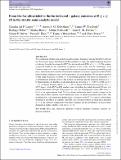Files in this item
From the far-ultraviolet to the far-infrared – galaxy emission at 0 ≤ z ≤ 10 in the shark semi-analytic model
Item metadata
| dc.contributor.author | Lagos, Claudia del P. | |
| dc.contributor.author | Robotham, Aaron S. G. | |
| dc.contributor.author | Trayford, James W. | |
| dc.contributor.author | Tobar, Rodrigo | |
| dc.contributor.author | Bravo, Matías | |
| dc.contributor.author | Bellstedt, Sabine | |
| dc.contributor.author | Davies, Luke J. M. | |
| dc.contributor.author | Driver, Simon P. | |
| dc.contributor.author | Elahi, Pascal J. | |
| dc.contributor.author | Obreschkow, Danail | |
| dc.contributor.author | Power, Chris | |
| dc.date.accessioned | 2019-09-25T11:30:06Z | |
| dc.date.available | 2019-09-25T11:30:06Z | |
| dc.date.issued | 2019-11 | |
| dc.identifier | 261352481 | |
| dc.identifier | ee97ecbc-4066-4e46-8e3a-042fa7584578 | |
| dc.identifier | 85075162450 | |
| dc.identifier.citation | Lagos , C D P , Robotham , A S G , Trayford , J W , Tobar , R , Bravo , M , Bellstedt , S , Davies , L J M , Driver , S P , Elahi , P J , Obreschkow , D & Power , C 2019 , ' From the far-ultraviolet to the far-infrared – galaxy emission at 0 ≤ z ≤ 10 in the shark semi-analytic model ' , Monthly Notices of the Royal Astronomical Society , vol. 489 , no. 3 , pp. 4196–4216 . https://doi.org/10.1093/mnras/stz2427 | en |
| dc.identifier.issn | 0035-8711 | |
| dc.identifier.other | ArXiv: http://arxiv.org/abs/1908.03423v3 | |
| dc.identifier.uri | https://hdl.handle.net/10023/18558 | |
| dc.description.abstract | We combine the shark semi-analytic model of galaxy formation with the prospect software tool for spectral energy distribution (SED) generation to study the multiwavelength emission of galaxies from the far-ultraviolet (FUV) to the far-infrared (FIR) at 0 ≤ z ≤ 10. We produce a physical model for the attenuation of galaxies across cosmic time by combining a local Universe empirical relation to compute the dust mass of galaxies from their gas metallicity and mass, attenuation curves derived from radiative transfer calculations of galaxies in the eagle hydrodynamic simulation suite, and the properties of shark galaxies. We are able to produce a wide range of galaxies, from the z = 8 star-forming galaxies with almost no extinction, z = 2 submillimetre galaxies, down to the normal star-forming and red-sequence galaxies at z = 0. Quantitatively, we find that shark reproduces the observed (i) z = 0 FUV-to-FIR, (ii) 0 ≤ z ≤ 3 rest-frame K-band, and (iii) 0 ≤ z ≤ 10 rest-frame FUV luminosity functions, (iv) z ≤ 8 UV slopes, (v) the FUV-to-FIR number counts (including the widely disputed 850 μm), (vi) redshift distribution of bright 850μm galaxies, and (vii) the integrated cosmic SED from z = 0 to 1 to an unprecedented level. This is achieved without the need to invoke changes in the stellar initial mass function, dust-to-metal mass ratio, or metal enrichment time-scales. Our model predicts star formation in galaxy discs to dominate in the FUV-to-optical, while bulges dominate at the NIR at all redshifts. The FIR sees a strong evolution in which discs dominate at z ≤ 1 and starbursts (triggered by both galaxy mergers and disc instabilities, in an even mix) dominate at higher redshifts, even out to z = 10. | |
| dc.format.extent | 4765473 | |
| dc.language.iso | eng | |
| dc.relation.ispartof | Monthly Notices of the Royal Astronomical Society | en |
| dc.subject | ISM: dust | en |
| dc.subject | Extinction | en |
| dc.subject | Galaxies: evolution | en |
| dc.subject | Galaxies: formation | en |
| dc.subject | Galaxies: luminosity function | en |
| dc.subject | QB Astronomy | en |
| dc.subject | QC Physics | en |
| dc.subject | 3rd-DAS | en |
| dc.subject.lcc | QB | en |
| dc.subject.lcc | QC | en |
| dc.title | From the far-ultraviolet to the far-infrared – galaxy emission at 0 ≤ z ≤ 10 in the shark semi-analytic model | en |
| dc.type | Journal article | en |
| dc.contributor.institution | University of St Andrews. School of Physics and Astronomy | en |
| dc.identifier.doi | 10.1093/mnras/stz2427 | |
| dc.description.status | Peer reviewed | en |
This item appears in the following Collection(s)
Items in the St Andrews Research Repository are protected by copyright, with all rights reserved, unless otherwise indicated.

